This Content Is Only For Paid Subscribers
Dean Stanberry provides insights into various aspects of commercial real estate, workplace dynamics, and the evolving nature of business operations.
Transcript
1:06 Systems & Process
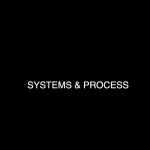 I’m fundamentally an operations guy. I value having well-defined policies, standards and procedures to guide work activities. Edward Demming famously said, “you can’t manage what you don’t measure”, and I had the opportunity to become certified in process management and quality improvement early in my career, and I’ve applied those practices throughout my work life.
I’m fundamentally an operations guy. I value having well-defined policies, standards and procedures to guide work activities. Edward Demming famously said, “you can’t manage what you don’t measure”, and I had the opportunity to become certified in process management and quality improvement early in my career, and I’ve applied those practices throughout my work life.
1:32 Shareholder To Stakeholder
 The 1960s kind of ushered in the open office environment or the sea of cubicles design. The 1980s kind of witnessed a shift to maximizing shareholder value, which incurred some collateral damage of diminished employee loyalty, making them expendable resources kind of at the whim of Wall Street quarterly earnings, and then the two thousands as experienced multiple economic and public health crises further diminishing individual prosperity and health and wellbeing. So after decades of abuse, I see employees have had enough and the pendulum is sort of swinging back towards engagement, favoring the workers’ terms.
The 1960s kind of ushered in the open office environment or the sea of cubicles design. The 1980s kind of witnessed a shift to maximizing shareholder value, which incurred some collateral damage of diminished employee loyalty, making them expendable resources kind of at the whim of Wall Street quarterly earnings, and then the two thousands as experienced multiple economic and public health crises further diminishing individual prosperity and health and wellbeing. So after decades of abuse, I see employees have had enough and the pendulum is sort of swinging back towards engagement, favoring the workers’ terms.
Back in the 1970s, the Freedman Doctrine, also known as the shareholder theory, posited that an entity does not have any social responsibility to the society around it whatsoever. Instead, he stated that the only responsibility that an entity should abide by is its shareholders. That doctrine was widely adopted by Wall Street and most major corporations. The shift from stakeholder to shareholder responsibility led to the elimination of really corporate loyalty, the employee body, and ultimately the massive pay and equity imbalances we see with executives and the average workers. Today, HR even adopted the label of human capital management, which I took to mean that workers were depreciated over five years and then written off. The employee revolt, I think, has taken about 50 years to manifest itself, but I think it’s here.
3:13 Do We Need An Office?
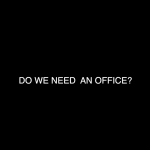 Why we need offices; That’s really a good question occupying much of the collective corporate mindshare at the moment. I believe knowledge workers really account for less than 25% of the total workforce, but that’s what’s dominating like 95% of the conversation. We’re very busy discussing what the office needs to look like and how occupants feel about the office and how much space is needed if everyone’s working from home most of the time. So the question of whether we need offices really seems to be in a bit of fluxx. I think it comes down to what functions are better served through in-person real-time interactions versus virtual interactions. That’s not the same from organization, organization or industry to industry. Some seem to be invested in coming up with a one size fits all solution, but that really doesn’t feel practical or realistic. I think the common themes for office engagement are innovation, collaboration, and then social and team building. There are productivity challenges that with everything being remote and virtual, and that’s not to say that people are not working, but we haven’t really figured out yet how to keep up with the normal pace of business in a solely virtual environment. Again, some have made it work in some limited scenarios, but I think there’s few very large scale examples that exist.
Why we need offices; That’s really a good question occupying much of the collective corporate mindshare at the moment. I believe knowledge workers really account for less than 25% of the total workforce, but that’s what’s dominating like 95% of the conversation. We’re very busy discussing what the office needs to look like and how occupants feel about the office and how much space is needed if everyone’s working from home most of the time. So the question of whether we need offices really seems to be in a bit of fluxx. I think it comes down to what functions are better served through in-person real-time interactions versus virtual interactions. That’s not the same from organization, organization or industry to industry. Some seem to be invested in coming up with a one size fits all solution, but that really doesn’t feel practical or realistic. I think the common themes for office engagement are innovation, collaboration, and then social and team building. There are productivity challenges that with everything being remote and virtual, and that’s not to say that people are not working, but we haven’t really figured out yet how to keep up with the normal pace of business in a solely virtual environment. Again, some have made it work in some limited scenarios, but I think there’s few very large scale examples that exist.
4:45 The Foundation
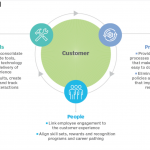 How do you organize the business? It starts with process. Then you got to get the right people, then you got to get the right tools in place, and we have a lot of new technologies that are coming out and people are buying into the technology and then trying to fit their process and their people to the technology. And that’s really kind of backwards in my mind. If you can’t make a process work on blue line paper, you’ll never get it to work in software. I think it goes back to that primary purpose of the organization or division within an organization and what processes and procedures they’ve developed to be successful. So those processes and procedures have both a logical and a physical characteristics built into ’em. In other words, there’s some assumptions about where activities occur and when the pandemic took the office out of the equation, organizations did not revamp all their processes and procedures around the office that were built around the office environment.
How do you organize the business? It starts with process. Then you got to get the right people, then you got to get the right tools in place, and we have a lot of new technologies that are coming out and people are buying into the technology and then trying to fit their process and their people to the technology. And that’s really kind of backwards in my mind. If you can’t make a process work on blue line paper, you’ll never get it to work in software. I think it goes back to that primary purpose of the organization or division within an organization and what processes and procedures they’ve developed to be successful. So those processes and procedures have both a logical and a physical characteristics built into ’em. In other words, there’s some assumptions about where activities occur and when the pandemic took the office out of the equation, organizations did not revamp all their processes and procedures around the office that were built around the office environment.
They simply put a bandaid procedures in place, assuming an eventual return to normal. Now we see attempts to return to a prior state of equilibrium that no longer exists. Organizations need to redefine their process. Success factors with new deliverable models that incorporate hybrid work. So throwing bagels and aromatherapy at the employee body really isn’t going to cut it. There are the physical design and amenities aspects for sure, but it occurs to me that the cultural, social and emotional factors have a greater influence and impact than furniture. Most people don’t leave their company, they leave their boss, and if you don’t have a good relationship with your boss, no amount of workplace design is going to fix that. If you have a workplace culture that was killing you before the pandemic and nothing has changed, why would you want to go back to the office for that soul crushing experience in person?
6:54 Motivators
 Every individual and every generation seems to have different motivators. We may be looking at different organizational structures and roles that separate the management work deliverables from managing people. So if someone is not meeting their work deliverables, it’s really difficult for a manager as separate the work deliverable concerns from the possible emotional or socioeconomic issues that affecting the individual’s performance. It may be in restructuring of how we manage talent, different industries have different operational process and procedures. The space model that works for an investment banking firm may not suit a healthcare organization. In Google’s early days, they determined that innovation occurred when teams were physically located and encouraged to socialize during the workday that motivated their design of their entire campus, providing collaborative workspaces, communal dining experiences, outdoor play spaces, and even personal care spaces like laundry areas. The lines between work life and personal life were really blurred. Well, that may not be desirable for everyone. They were able to attract talent largely based on the environment that they offered. Now, not many bay organizations have been able to make such a claim as time progresses and personal needs and taste change. So do the space needs of the organization. I think the trick is anticipating those perceptual changes and adjusting spaces to accommodate them. But to date, I think few have really mastered that ability.
Every individual and every generation seems to have different motivators. We may be looking at different organizational structures and roles that separate the management work deliverables from managing people. So if someone is not meeting their work deliverables, it’s really difficult for a manager as separate the work deliverable concerns from the possible emotional or socioeconomic issues that affecting the individual’s performance. It may be in restructuring of how we manage talent, different industries have different operational process and procedures. The space model that works for an investment banking firm may not suit a healthcare organization. In Google’s early days, they determined that innovation occurred when teams were physically located and encouraged to socialize during the workday that motivated their design of their entire campus, providing collaborative workspaces, communal dining experiences, outdoor play spaces, and even personal care spaces like laundry areas. The lines between work life and personal life were really blurred. Well, that may not be desirable for everyone. They were able to attract talent largely based on the environment that they offered. Now, not many bay organizations have been able to make such a claim as time progresses and personal needs and taste change. So do the space needs of the organization. I think the trick is anticipating those perceptual changes and adjusting spaces to accommodate them. But to date, I think few have really mastered that ability.
8:39 The Best Environment
 For the knowledge worker, it occurs to me that the key to creating a frictionless environment promotes engagement, productivity, and satisfaction, which is far easier said than done. It involves not only the workplace but the technology environment, accommodations for work hours, and an engaging organizational culture. This is an example where leadership and support organizations like HR, IT and real estate must really work together to create that best environment for their organization. I think most organizations still consider the workspace a cost center rather than a component of their revenue generation. Space should be measured based on its value to the intended business function. That’s rare in the current environment, but a sleek modern car dealership likely attracts more potential buyers than some uninviting dull box building dealership down the street. The sleek, modern building may have cost more to create, but it probably generates more revenue. Secondly, organizations must recognize that buildings and their operations are a component of the overall business success.
For the knowledge worker, it occurs to me that the key to creating a frictionless environment promotes engagement, productivity, and satisfaction, which is far easier said than done. It involves not only the workplace but the technology environment, accommodations for work hours, and an engaging organizational culture. This is an example where leadership and support organizations like HR, IT and real estate must really work together to create that best environment for their organization. I think most organizations still consider the workspace a cost center rather than a component of their revenue generation. Space should be measured based on its value to the intended business function. That’s rare in the current environment, but a sleek modern car dealership likely attracts more potential buyers than some uninviting dull box building dealership down the street. The sleek, modern building may have cost more to create, but it probably generates more revenue. Secondly, organizations must recognize that buildings and their operations are a component of the overall business success.
Some studies indicate that poorly designed and operated spaces affect productivity which affects profitability. I think it depends on the purpose of the space. A headquarters building often serves to promote the company brand as well as how’s its leadership. A space for product development and support may be measured in terms of work group productivity and therefore part of the overall product development cost. A Wall Street trading floor or trading space may be measured in terms of overall profitability based on how well the design supports split second decision-making. However, a few organizations go to that to the effort of developing metrics that measure the value of their space.
10:38 Mission & Vision
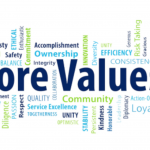 You got to epitomize the organization’s mission, vision, and values. I see a lot of organizations who do not; they don’t exhibit their values in their daily practices and employees see that. And so why are they surprised when the employees don’t exhibit those values that they espouse? It’s looking at people-centered leadership, working with people to accomplish their goals and the organization’s goals. There is at least some indications of a shift from the shareholder back to stakeholder oriented leadership. Too many priorities and decisions are based strictly on profit motive and meeting some artificial Wall Street expectations, but social equity and the economy are not really the same thing as Wall Street. I think they need to recognize that commercial real estate is really behind in digital transformation. The industry needs to raise the bar on technology skills and experience to take advantage of this tsunami of technology solutions that are now flooding the commercial real estate marketplace.
You got to epitomize the organization’s mission, vision, and values. I see a lot of organizations who do not; they don’t exhibit their values in their daily practices and employees see that. And so why are they surprised when the employees don’t exhibit those values that they espouse? It’s looking at people-centered leadership, working with people to accomplish their goals and the organization’s goals. There is at least some indications of a shift from the shareholder back to stakeholder oriented leadership. Too many priorities and decisions are based strictly on profit motive and meeting some artificial Wall Street expectations, but social equity and the economy are not really the same thing as Wall Street. I think they need to recognize that commercial real estate is really behind in digital transformation. The industry needs to raise the bar on technology skills and experience to take advantage of this tsunami of technology solutions that are now flooding the commercial real estate marketplace.
Organizational and technological silos still constrain the industry. There are historical artifacts that consume additional resources and support. They duplicate systems functionality and complicate communication. Therefore, CRE really needs to promote technology integration, data governance, and really lifecycle thinking across the transactional and operational disciplines. And I think around things like commute, scheduling, how are we increasing the number of choices that impact the office? Much like the proliferation of communication methods, increased workplace choices are not necessarily a benefit. Communication has become more complicated and time consuming with the options of phone and email, text messaging, and an insane number of social media platforms. And I anticipate a similar complication as we increase the number of workspace choices. When a group needs to meet in person, we’ll spend more time deciding not just on the date and time, but where the number of communication and workspace choices is likely to be more of a detrimental productivity than a benefit. I would say.
13:10 Focus On The Problem
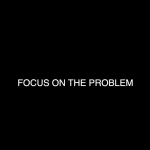 It doesn’t do us a lot of good to implement a very sophisticated technology platform and then hand it over to people that have no idea what to do with it. That doesn’t help you. We also, I don’t see a lot of positions that help people decide what sort of functionality do they need and so they often get enamored by the shiny new object. They get enamored by some product demo, which product demos generally always work, but they haven’t really sat down and said, what business functions am I trying to solve? What are my functional requirements? When I’m looking at a piece of software, how do I tell whether or not it’s going to solve the problems that I have? And we have far too many pieces of software. There’s a lot of tools out there that focus on a very narrow range of functionality, but almost all technology today must integrate or talk to other pieces of technology.
It doesn’t do us a lot of good to implement a very sophisticated technology platform and then hand it over to people that have no idea what to do with it. That doesn’t help you. We also, I don’t see a lot of positions that help people decide what sort of functionality do they need and so they often get enamored by the shiny new object. They get enamored by some product demo, which product demos generally always work, but they haven’t really sat down and said, what business functions am I trying to solve? What are my functional requirements? When I’m looking at a piece of software, how do I tell whether or not it’s going to solve the problems that I have? And we have far too many pieces of software. There’s a lot of tools out there that focus on a very narrow range of functionality, but almost all technology today must integrate or talk to other pieces of technology.
And we don’t have a common industry data model that facilitates exchange of information so that a piece of information in one tool is the same piece of information in another tool. Commercial real estate generally has poor data quality, and whether that’s drawings or asset details or maintenance history, it’s really challenging to do good forecasting if your trending data is bad or non-existent. Everybody needs to develop a little bit of, I guess, skepticism, healthy skepticism to say, “yeah, the tools are great”, but I need to know, I need to be able to ask the question to say is the information I’m getting accurate?
15:14 The Learning Experience
 One of the things that I think we’ve lost a little bit is learning experiences where you have more experienced individuals that can mentor the less experienced staff. With this increasingly distributed workforce, there are fewer opportunities for such real-time learning opportunities to stuff that you don’t get out of a textbook. It’s that on the job practical one-on-one, you’re learning from the people who have done it for years and now many people come into a job and they don’t have that opportunity. They have to again, stumble through it on their own. It’s taking a practical learning opportunity or a project and getting some available subject matter expert participants, some available junior staff who need to learn and leadership who proactively orchestrates those opportunities. And I don’t see much of that occurring these days. If managed properly, it could us benefit to know when someone is planning to be office in the office or if they’re in the office. Now, this is particularly useful when you need to meet with two or more people and you’re trying to figure out and you want it to be in person and you need to figure out when you’re all going to be at the same place at the same time.
One of the things that I think we’ve lost a little bit is learning experiences where you have more experienced individuals that can mentor the less experienced staff. With this increasingly distributed workforce, there are fewer opportunities for such real-time learning opportunities to stuff that you don’t get out of a textbook. It’s that on the job practical one-on-one, you’re learning from the people who have done it for years and now many people come into a job and they don’t have that opportunity. They have to again, stumble through it on their own. It’s taking a practical learning opportunity or a project and getting some available subject matter expert participants, some available junior staff who need to learn and leadership who proactively orchestrates those opportunities. And I don’t see much of that occurring these days. If managed properly, it could us benefit to know when someone is planning to be office in the office or if they’re in the office. Now, this is particularly useful when you need to meet with two or more people and you’re trying to figure out and you want it to be in person and you need to figure out when you’re all going to be at the same place at the same time.
16:34 Create The System
 Commercial real estate needs to encourage systems thinking that spans organizational roles and responsibilities. When I talk about silos is people, they have a starting point and an ending point for what they do, and they really don’t look at how did that data get you in the first place and how’s it going to be used after it leaves your role and responsibility? That’s lifecycle perspective, taking it across the entire lifecycle of a process or a service and understanding what it is and making sure that everybody’s needs are met on the process inputs and your process outputs. You have to have a process and a repeatable process in order to measure it. And so at some level, you got to have that. Organizations that haven’t evaluated their current processes and whether they’re working, they need to undertake that task of re-imagining their processes and procedures to return to some sort of a successful state.
Commercial real estate needs to encourage systems thinking that spans organizational roles and responsibilities. When I talk about silos is people, they have a starting point and an ending point for what they do, and they really don’t look at how did that data get you in the first place and how’s it going to be used after it leaves your role and responsibility? That’s lifecycle perspective, taking it across the entire lifecycle of a process or a service and understanding what it is and making sure that everybody’s needs are met on the process inputs and your process outputs. You have to have a process and a repeatable process in order to measure it. And so at some level, you got to have that. Organizations that haven’t evaluated their current processes and whether they’re working, they need to undertake that task of re-imagining their processes and procedures to return to some sort of a successful state.
Then they need to look at their people. Do you have the right people with the right skills to execute the processes? Goes back to that upskilling question. Then lastly is what you look at is the tools determine if you have the right tools to support your processes and people. As simple as it sounds, many organizations attack these items in exactly the wrong order. It’s processes, then people, then tools. I’ve never seen it work well in any other order. Many years ago I learned an insightful tip from an auditor actually. At a macro level, he looked at, he said there’s a constant interchange between what he defined as people, processes and machine processes. And he says it’s often at these exchange points where most of the errors and omissions occur. So space likely comes into the picture at any number of those interchange points. From a design perspective, starting to understand the organization’s functioning at a macro level to ensure that those change points are accounted for is something I don’t see either. That happens very often.
18:54 Experience Information
 It occurs to me that experience is often measured by looking to the past. What we use today is like employee satisfaction surveys to evaluate an individual’s experience over some prior period. And often those evaluations compare responses against some predetermined desired result, and the evaluation questions frequently are biased towards that desired result. Maybe it’s unconscious, but that’s the way it kind of works out. We have to ask whether we’re trying to measure the variance from a desired outcome or just to understand the individual’s experience without any preconceived perceptions. You have financial data, procedural data, individual performance data process performance data, market data, and really the list goes on. Whatever you’re looking at, I tend to have three characteristics of the data. Is it complete, is it accurate, and is it timely? Complete refers to whether or not the data really encompasses all aspects of what’s being tracked.
It occurs to me that experience is often measured by looking to the past. What we use today is like employee satisfaction surveys to evaluate an individual’s experience over some prior period. And often those evaluations compare responses against some predetermined desired result, and the evaluation questions frequently are biased towards that desired result. Maybe it’s unconscious, but that’s the way it kind of works out. We have to ask whether we’re trying to measure the variance from a desired outcome or just to understand the individual’s experience without any preconceived perceptions. You have financial data, procedural data, individual performance data process performance data, market data, and really the list goes on. Whatever you’re looking at, I tend to have three characteristics of the data. Is it complete, is it accurate, and is it timely? Complete refers to whether or not the data really encompasses all aspects of what’s being tracked.
Expense data is not complete if you’re missing several categories of your spending. Accurate refers to the trustworthiness. Is the data source verified to be accurate and therefore trustworthy? And timeliness refers to whether the data is being collected and reported in a timeframe that’s useful and relevant to the business. All data is sort of historical in nature. Data for the current week or month is helpful to portray current trends. Data from a year ago may be also helpful, but it conveys a longer trend period. What is most useful for your measurements? To me, square footage is a metric, but it’s not a key performance indicator.
If the organization is trying to reduce its square footage per person, you can certainly measure that but whether the reduction has a positive or negative impact on the organization’s goals and objectives is really a different question. For an office, total seating capacity and the average daily occupancy would seem helpful, and these are metrics, but how they drive business is probably organizationally dependent. When viewed in isolation, it’s interesting information, but it probably doesn’t tell you much without looking at some of the other related factors. What is it about this space that is enabling us to be successful at what we do? Deming famously said, “you can’t manage what you don’t measure”. Organizations got to start with their processes to determine what they will measure within those processes and what measurement values determine success. Some organizations measure too much and they kind of lose sight of their objectives. Only measure things that will actually drive action if they veer off course. If the data doesn’t drive any action collecting, it really wastes time and resources.
22:07 Managing Projects
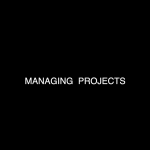 Quality management principles suggests that processes should be continually evaluated and adjusted as needed. This is the famous plan: do, check, act, cycle. Everybody’s seen that. As the saying goes, the only constant is change. If processes stay the same, the organization’s likely falling behind the times and failure is probably imminent. I think everything comes down to people time and money. And when it comes to projects, you can have it good, fast or cheap. Pick two, you can’t do all three. If you have done an adequate job of defining the design requirements, provided an acceptable budget range and dedicated the appropriate resources, then the maximum value would be a design solution that meets the project requirements that can be delivered on time and on budget.
Quality management principles suggests that processes should be continually evaluated and adjusted as needed. This is the famous plan: do, check, act, cycle. Everybody’s seen that. As the saying goes, the only constant is change. If processes stay the same, the organization’s likely falling behind the times and failure is probably imminent. I think everything comes down to people time and money. And when it comes to projects, you can have it good, fast or cheap. Pick two, you can’t do all three. If you have done an adequate job of defining the design requirements, provided an acceptable budget range and dedicated the appropriate resources, then the maximum value would be a design solution that meets the project requirements that can be delivered on time and on budget.
23:03 Leading The Team
 It really starts with that executive sponsorship and a program that’s kind of aligned with the organization’s vision and strategy. Without that solid base, nothing else matters. If you don’t have that executive sponsorship or you’re not following the strategy, the organization, that’s sort of like the first step on the road to failure change management is about stirring organizational culture and behavior. First you must understand what are the perceived cultural norms followed by what are the actual cultural norms? Because perception and reality are often different things, right? Executive leadership has to kind of establish those parameters and goals or what is the desired organizational culture state? And from there you can look at the relevant data from all of the data. It’s not everything but the subset that will help drive change from that ‘what is’ state to the ‘to be’ state communication is always critical.
It really starts with that executive sponsorship and a program that’s kind of aligned with the organization’s vision and strategy. Without that solid base, nothing else matters. If you don’t have that executive sponsorship or you’re not following the strategy, the organization, that’s sort of like the first step on the road to failure change management is about stirring organizational culture and behavior. First you must understand what are the perceived cultural norms followed by what are the actual cultural norms? Because perception and reality are often different things, right? Executive leadership has to kind of establish those parameters and goals or what is the desired organizational culture state? And from there you can look at the relevant data from all of the data. It’s not everything but the subset that will help drive change from that ‘what is’ state to the ‘to be’ state communication is always critical.
It must be constant, consistent, and relevant to the audience. The message to the rank and file employees is different than that to the executive leadership or to the shareholders. When it comes to achieving change, the desired change state is time consuming and requires patience and persistence. I’m always flabbergasted when you see some new executive come in and says, we’re going to change our corporate culture in 90 days. The pace of change seems ever accelerating. I thought it was fast-paced back in the seventies and eighties, and it’s orders of magnitude beyond that today. And few organizations can really escape that grasp. Some emerging trends will affect specific industries more than others, and some are going to affect them all. If we take circular economy as an example of a trend that’s going to affect all industries, whether you’re a supplier or a consumer of goods or services, workplace wellness and wellbeing seems focused on the knowledge worker sector, but it certainly impacts all categories of workers.
For the CRE industry, PropTech has really had a significant impact on all aspects of the industry, and that’s what’s forcing this upskilling requirement really across all roles and responsibilities. It doesn’t matter what job you have across commercial real estate, everybody needs to know more than they know today. There’s many trends affecting CRE within an organization. The head of real estate really must work with that executive leadership to regularly confirm strategic direction and priorities. Direction and priorities then must be communicated down through the CRE organization with a directive to identify any potential impacts on the current CRE strategy programs, processes, and procedures. This post pandemic environment is unfamiliar territory, and so we will require diligence and flexibility to navigate that terrain.
26:23 What’s Next
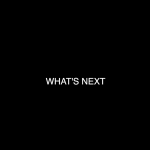 Commercial real estate’s going to remain sort of a tumultuous environment for the foreseeable future. The savvy CRE leaders are going to carve out more time to study emerging trends and projections by knowledgeable industry thought leaders, all that while maintaining no doubt a heavy workload. They also need to evaluate the skill levels of their team and invest in upskilling where it’s needed. They’re going to need an exceptional team to keep pace with the anticipated changing workplace strategies and priorities. I look at the evolution of facility management and the function is changing. We’re getting more and more things put onto the facility management role. That’s what I think is trying to lay that out to expose to people what is changing in the role? Where do they need to upgrade their skills in order to be successful going forward?
Commercial real estate’s going to remain sort of a tumultuous environment for the foreseeable future. The savvy CRE leaders are going to carve out more time to study emerging trends and projections by knowledgeable industry thought leaders, all that while maintaining no doubt a heavy workload. They also need to evaluate the skill levels of their team and invest in upskilling where it’s needed. They’re going to need an exceptional team to keep pace with the anticipated changing workplace strategies and priorities. I look at the evolution of facility management and the function is changing. We’re getting more and more things put onto the facility management role. That’s what I think is trying to lay that out to expose to people what is changing in the role? Where do they need to upgrade their skills in order to be successful going forward?
3 Things To Do Right Now:
- Measure What Matters: Implement metrics and data collection that truly measure the effectiveness of your processes and people. Make sure the data collected is complete, accurate, and timely. Use these metrics to drive action and improvements. When evaluating office space, measure its value based on its contribution to the intended business function rather than simply focusing on square footage. Assess how the space supports the organization’s goals and objectives.
- Adopt a Systems Thinking Approach: Encourage a holistic perspective across organizational roles and responsibilities. Avoid silos and ensure that employees understand how their work impacts others and the organization as a whole. Your space should create constant interaction across all of your teams.
- Invest in Upskilling: Recognize that the commercial real estate industry is rapidly evolving due to technology and changing workplace trends. Invest in upskilling your workforce to keep up with emerging trends and technologies. Adopt a culture of continuous improvement. Regularly evaluate and adjust processes and procedures to ensure they remain effective and aligned with the organization’s evolving needs.
Bonus Clip: Lessons Learned
Resources:
- Connected FM Podcast
- Evolution Is Never Finished: Insights From IFMA’s Emerging Topics Working Group On How Six Key Topics Are Transforming The FM Industry (Whitepaper)
- Workplace Evolutionaries (WE) Webinars
- View Dean’s LinkedIn profile
Meet Dean Stanberry:
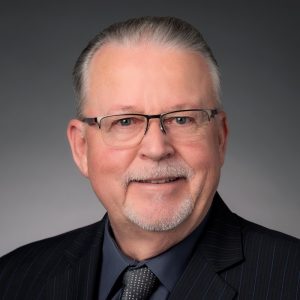 Dean Stanberry has more than 20 years of broad-based experience in facility management, real estate portfolio management, process and quality improvement, procurement, workplace services, program and project management, space and occupancy planning, sustainability, information systems implementation, and critical environment operations.
Dean Stanberry has more than 20 years of broad-based experience in facility management, real estate portfolio management, process and quality improvement, procurement, workplace services, program and project management, space and occupancy planning, sustainability, information systems implementation, and critical environment operations.
He is an active industry advocate, serving on the IFMA Foundation Board of Trustees, is past chair of the Environmental Stewardship, Utilities, and Sustainability (ESUS) Community, and chairs the Government Affairs Committee. Dean is currently 1st Vice-Chair of IFMA’s Global Board of Directors.
Episode 4 Part 1 Credits:
- Created By Bob Fox
- Produced By Work Design Magazine
- Directed By Bob Fox
- Edited By Katie Sargent & Bob Fox
- Special Thanks to Amanda Gram

